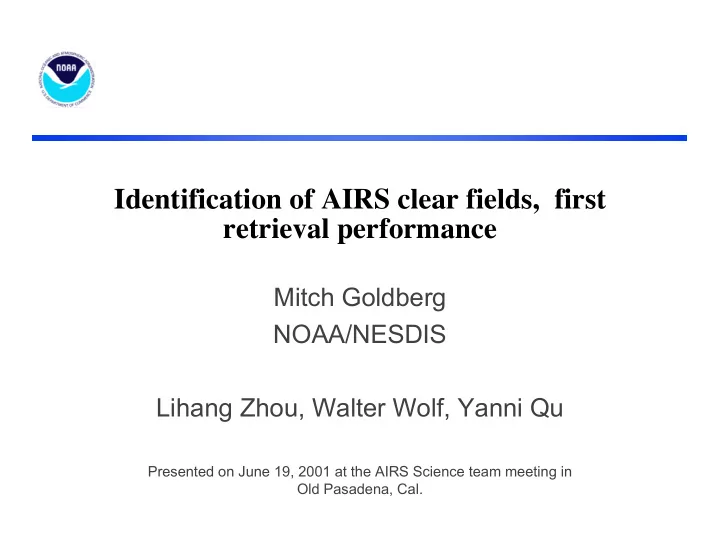

Identification of AIRS clear fields, first retrieval performance Mitch Goldberg NOAA/NESDIS Lihang Zhou, Walter Wolf, Yanni Qu Presented on June 19, 2001 at the AIRS Science team meeting in Old Pasadena, Cal.
BACKGROUND • NESDIS will be distributing AIRS radiances to NWP centers in near real-time. • NWP centers will assimilate clear radiances • Need very good cloud detection algorithm • Very important for radiance validation and to initiate the testing of the level 2 retrieval code.
Objectives • Provide information indicating if fov is clear with a confidence indicator. • If not clear: - provide cloud amount and height. - indicate channels not affected by clouds
Clear Detection – Combination of 3 tests • AMSU channels 4, 5 and 6 are used to predict AIRS channel at 2390.9 cm-1. Predicted AIRS at 2390.9 = 11.327-.185*amsu4+1.930*amsu5- 0.777*amsu6+1.048*csza-4.243*(1.-cang) where csza = cosine solar zenith angle cang = cosine view angle (scan angle) amsu4 = amsu channel 4 brightness temperature , etc • FOV is labeled “mostly clear” if predicted AIRS – observed AIRS < 2 AND IF • SW LW IR window test is successful: [ch(2558.224)-CH(900.562)] < 10 K • Variability of 2390.910 radiance within 3x3 < 0.0026
Limitations • Simulations have random cloud emissivities – spectrally uncorrelated. • So cannot investigate spectral cloud signatures to identify clouds. (mean = 0.98 , sdv = .01)
Total cloud (3 tests) True clear (< 2%)
Improvements to cloud detection • Shortwave window channels compared to longwave window channels are more sensitive to clouds due to non-linearity of Planck function in the case of partly cloudy situations. • At night shortwave and longwave windows for overcast conditions will be similar. • During day reflected solar allows detection of clouds. (easier to detect clouds during the day) • Predicting shortwave window channels from longwave is very useful. Coefficients derived from clear.
Predicting SST from 11 and 8 micron channels • SST from 918.65, 965.32, 1228.09, 1236.40 DEP VAR: SURFT N: 2289 MULTIPLE R: 1.000 SQUARED MULTIPLE R: 0.999 • ADJUSTED SQUARED MULTIPLE R: .999 STANDARD ERROR OF ESTIMATE: 0.23695 • VARIABLE COEFFICIENT STD ERROR STD COEF TOLERANCE T P(2 TAIL) • CONSTANT 8.28206 0.26327 0.00000 . .31E+02 0.00000 • LWO(26) -0.97957 0.01436 -0.85447 0.00243 -.68E+02 0.00000 • LWO(29) 0.60529 0.05165 0.56538 0.00016 .12E+02 0.00000 • MWO(65) 1.74444 0.05713 1.60310 0.00014 .31E+02 0.00000 • MWO(66) -0.40379 0.00929 -0.32981 0.00663 -.43E+02 0.00000 •
Scatter diagrams of cloud tests vs cloud amount Night ocean Granule 401 December 15, 2000 Predicted AIRS 2390 – Observed
3 x 3 spatial coherence test of 2390 cm-1 channel
Cloud pressure vs. Cloud amount for original cloud tests residual error is 2.5% -- need better tests Predicted AIRS from AMSU and adding coherence test ~2.5%
Improved Cloud Detection • Better tests are derived by predicting 2616 cm-1 channel from 11 or 8 micron channels. • Comparing SST with 2616 at Night. • Predicting SST from 11 and 8 micron channels (works for day and night)
Can compare 900 cm-1 with 2616, but highly dependent on TPW
A solution is to predict 2616 from longwave channels Predicting 2616 from 8 micron (rms = .5) from 8 and 11 (rms = .2) Observed minus predicted vs. Total cloud amount
Results are better if predictor channels are limited to a small spectral region 11 or 8 micron not 11 and 8 micron (see previous slide) Predicting 2616 from 8 micron (rms = .5) from 11 micron (rms = .2)
Observed 2616 minus predicted vs. total cloud fraction
Select threshold by using cumulative distribution function and assume that 5% of globe is clear. Threshold ~ 0.2 K Observed 2616 minus predicted 2616 BT Observed 2616 minus predicted 2616 BT
Predict 2616 from 8 micron channels (4 channels) and if observed 2616 minus predicted < .2 then the fov is clear. Residual bias error is 0.6% with rms of 1.6% cloud amount Observed minus predicted vs. cloud amount Locations of clear fovs (.006, .016)
To get rid of residual clouds, the use of NCEP SST is very important SST - Predicted SST SST - 2616
Approach to selecting “good” threshold : use cumulative probability distribution SST SST Observed SST minus Predicted SST Observed SST minus Predicted SST
Cumulative distribution function for SST minus 2616 Observed SST minus 2616 BT Observed SST minus 2616 BT
Location of detected clear locations Blue = 2616 approach, Red = predicting SST approach
Histogram of actual cloud amount for detected clear cases (observed SST – predicted < 0.2 K) Residual bias = 0.2 %, rms = 0.5 % (.002,.005)
Clear simulated vs. observed results • December 15, 2000 • Radiances generated from NESDIS NRT system with clouds. • Cloud detection coefficients generated from December 10, 2000 • Use Larrabee’s code to simulated radiances from NESDIS global grids of NCEP forecast (truth) • NRT system produce 1x1 global grids of truth, 281 channel subset and principal components.
N=2923 29% (10.5%) (.09,.14) (.03,.07) 11.2% 4.5% (.018,.036)
5.6%
5.7% 5.5% (.005, .008)
Day 1 Strategy • Use 2616 vs SST to find night clear cases. • Generate coefficients to predict SST from small set (4) 11 and 8 micron channels. • Generate retrieval regression coefficients for ocean clear cases. • Test retrieval algorithm for clear ocean data.
Detected Clear FOVS via predicting SST
Conclusion • Use of SST from NCEP analysis is important. • Start out using SST – 2616 channels (night). • Use cumulative distribution function of SST- predicted SST to determine threshold. • For Day 1 - Generate regression coefficients for ocean clear. • Test retrieval algorithm on ocean clear data before tackling other situations. • Day 2: test partial overcast over sea to test cloud clearing. • Experiment with MODIS.
Recommend
More recommend